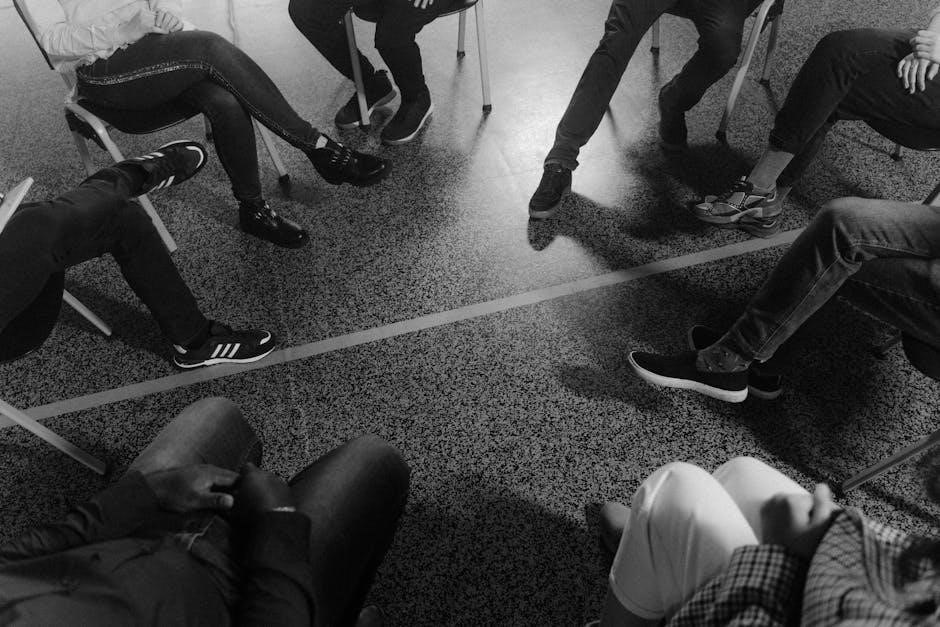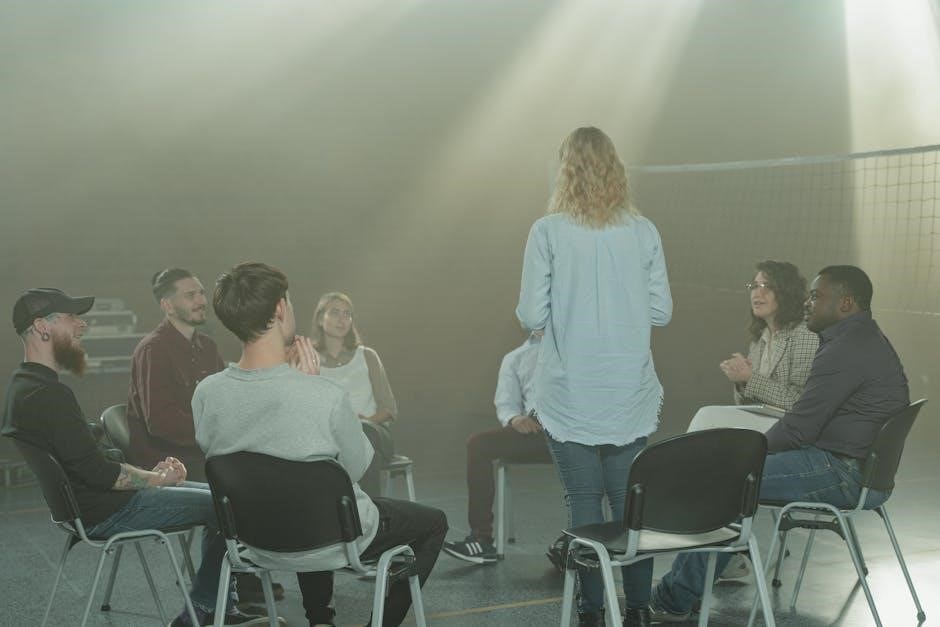Social psychology explores how individuals think, feel, and behave in social contexts. David Myers’ work highlights its relevance in understanding human interactions, attitudes, and societal influences.
1.1 Definition and Scope of Social Psychology
Social psychology is the scientific study of how individuals think, feel, and behave in social contexts. It examines cognitive processes, social interactions, and the influence of culture and society on human behavior. The field explores topics such as attitudes, persuasion, group dynamics, and interpersonal relationships. By understanding these elements, social psychology provides insights into why people act and think as they do in various social situations. Its scope extends to real-world applications, offering practical knowledge to improve social interactions and address societal challenges.
1.2 The Importance of Social Psychology in Understanding Human Behavior
Social psychology is crucial for understanding human behavior as it examines how cognitive processes, social interactions, and cultural influences shape actions and decisions. By studying these elements, it provides insights into real-world issues like communication, prejudice, and aggression, offering practical solutions to improve societal well-being. This knowledge helps address everyday challenges, such as fostering empathy and cooperation, and can be applied in various fields, including education and healthcare, to promote positive social change effectively.
1.3 David Myers’ Contribution to the Field
David Myers has significantly advanced social psychology through his engaging textbooks and research. His works, such as “Social Psychology,” have made complex concepts accessible, emphasizing real-world applications. Myers’ focus on cognitive dissonance, group dynamics, and human behavior has provided foundational knowledge. His ability to integrate scientific rigor with readability has made his texts indispensable in education. Myers’ contributions continue to inspire new generations of students and researchers, fostering a deeper understanding of social interactions and their impact on human behavior and societal structures.

Social Thinking
Social thinking examines how cognitive processes influence perceptions, judgments, and decisions. It explores mental shortcuts, biases, and the role of schemas in shaping social understanding and behavior.
2.1 Cognitive Dissonance and Its Impact on Decision-Making
Cognitive dissonance, introduced by Leon Festinger, refers to the mental discomfort experienced when holding conflicting thoughts or values. According to David Myers, this discomfort motivates individuals to reduce dissonance by altering their beliefs, attitudes, or behaviors. In decision-making, cognitive dissonance often leads to post-purchase rationalization, where people justify their choices to align their actions with their self-image. Myers emphasizes that this psychological mechanism plays a crucial role in shaping attitudes and behaviors, highlighting the dynamic interplay between cognition and emotion in social contexts.
2.2 Heuristics and Biases in Social Judgment
Heuristics are mental shortcuts that simplify decision-making, while biases are systematic errors in thinking. David Myers highlights how heuristics, like the representativeness heuristic, often lead to flawed judgments. For instance, people overemphasize vivid examples, ignoring base rates. Biases, such as confirmation bias, further distort social judgments by favoring information that aligns with preexisting beliefs. Myers explains that these cognitive shortcuts and biases are not errors but rather efficient, though imperfect, strategies for navigating complex social environments. Understanding them is crucial for improving decision-making and reducing irrational thinking.
2.3 The Role of Schemas in Shaping Social Perceptions
Schemas are mental frameworks that organize and structure knowledge, influencing how we perceive and interpret social information. David Myers explains that schemas act as shortcuts, helping us make sense of complex situations. For example, schemas about social roles or stereotypes can shape expectations and interactions. While schemas enhance efficiency, they can also lead to oversimplifications or biases. Myers emphasizes that schemas are dynamic, evolving as new experiences challenge or reinforce existing mental frameworks. Understanding schemas is key to recognizing how perceptions are constructed and how they influence social judgments and behaviors.
The Self in a Social World
The self is shaped by social interactions, self-perception, and cultural influences, forming a dynamic identity that influences behavior and social dynamics.
3.1 The Concept of Self and Identity
The concept of self refers to the individual’s perception of their identity, encompassing personal beliefs, values, and social roles; Identity emerges from interactions within social contexts.
3.2 Social Identity Theory and Group Membership
Social Identity Theory posits that individuals derive a sense of identity from their group memberships. These memberships shape self-concept and behavior, fostering in-group favoritism and intergroup bias. As David Myers discusses, group membership provides a sense of belonging and defines social roles, influencing how individuals perceive themselves and others. This theory, developed by Tajfel and Turner, highlights the psychological importance of social categorization and its impact on prejudice and discrimination, underscoring the dual nature of group dynamics in fostering unity and conflict.
3.3 The Influence of Culture on Self-Perception
Culture profoundly shapes self-perception, influencing how individuals view themselves and their place within society. In collectivist cultures, identity is often rooted in group harmony and interdependence, while individualist cultures emphasize personal achievement and autonomy. David Myers highlights how cultural norms, values, and social practices mold self-concept, impacting self-esteem and behavior. Understanding these cultural differences is crucial for appreciating the diverse ways people construct and experience their sense of self, as explored in Myers’ work on social psychology.

Social Beliefs and Judgments
Social beliefs and judgments shape how individuals perceive and interpret social information, influencing attitudes, behaviors, and interactions in complex societal contexts.
4.1 Attitudes and Their Formation
Attitudes are enduring evaluations of people, objects, or ideas, shaped by experiences, learning, and social interactions. David Myers’ work explains how these attitudes form through cognitive processes, personal experiences, and cultural influences, impacting behavior and decision-making in various social contexts.
4.2 The Relationship Between Attitudes and Behavior
The relationship between attitudes and behavior is complex, as attitudes often, but not always, predict behavior. David Myers highlights that while strong attitudes can guide behavior, factors like situational constraints and social norms may weaken this link, influencing whether attitudes translate into actions in real-world scenarios.
4;3 Prejudice, Stereotypes, and Discrimination
Prejudice, stereotypes, and discrimination are deeply intertwined, often leading to unfair treatment of individuals based on group membership. Prejudice refers to preconceived, often negative attitudes toward a group, while stereotypes are oversimplified beliefs about group characteristics. Discrimination involves acting on these biases, perpetuating inequality. David Myers emphasizes how these social phenomena harm individuals and society, highlighting the need for strategies like education and intergroup contact to reduce bias and foster understanding. Addressing these issues is crucial for promoting social justice and harmony.

Behavior and Attitudes
Behavior and attitudes are intricately linked, with actions often reflecting and shaping beliefs. Social norms, persuasion, and obedience significantly influence both, as explored in Myers’ work.
5.1 The Power of Social Influence on Behavior
Social influence profoundly shapes behavior, as individuals often conform to group norms or comply with social pressures. David Myers’ work highlights how group size, unanimity, and social norms intensify these effects. Conformity occurs when people adopt majority opinions, while compliance involves acting to gain approval. Myers’ research shows that even in dissent, individuals may privately doubt but publicly agree. Understanding these dynamics helps explain phenomena like crowd behavior and cultural trends, emphasizing the pervasive role of social forces in guiding human actions and decision-making across various contexts.
5.2 Persuasion Techniques and Their Effectiveness
Persuasion techniques leverage psychological principles to influence attitudes and behaviors. According to David Myers, methods like reciprocity, authority, and scarcity enhance persuasive power. The foot-in-the-door technique, where small requests precede larger ones, often increases compliance. Myers also emphasizes the role of credibility and emotional appeals in persuasion. These strategies are effective because they align with cognitive shortcuts, reducing decision-making effort. Understanding these techniques helps individuals critically evaluate persuasive messages and make informed choices, while also enabling effective communication in various social and professional contexts.
5.3 The Role of Obedience in Social Psychology
Obedience, a key aspect of social psychology, examines how individuals comply with authority figures or societal norms. David Myers highlights obedience as a powerful force shaping behavior, often leading to conformity. The Milgram experiment, discussed in Myers’ work, demonstrates how ordinary individuals can act destructively when obeying orders. Obedience is influenced by factors like authority presence, social norms, and fear of punishment. Understanding obedience helps explain phenomena like groupthink and authoritarian behavior, emphasizing the importance of critical thinking in resisting harmful directives while fostering positive social outcomes through ethical leadership and autonomy. Obedience remains a critical area of study in social psychology, offering insights into human behavior and societal dynamics.

Social Influence and Conformity
Social influence shapes behavior through conformity, compliance, and obedience. David Myers explores how group dynamics and norms lead individuals to align with others, often unintentionally.
6.1 The Dynamics of Conformity and Compliance
Conformity refers to changing one’s behavior to align with a group, often due to social pressure or the desire to fit in. Compliance involves yielding to explicit requests, influenced by authority or norms. David Myers discusses how these dynamics shape individual actions, highlighting the subtle yet powerful ways groups enforce uniformity. His work emphasizes the role of norms, leadership, and situational factors in driving these behaviors, illustrating how easily external pressures can override personal judgment and autonomy in social settings.
6.2 The Impact of Group Size on Social Influence
Group size significantly influences social influence, with smaller groups often fostering personalized interactions and larger groups promoting conformity. David Myers highlights that as group size increases, individuals may feel less personal responsibility, leading to diffusion of accountability. This can result in reduced effort or engagement, a phenomenon known as social loafing. Conversely, smaller groups allow for more direct influence and accountability, enhancing individual contributions. Myers’ work underscores how group size shapes behavior, emphasizing that social dynamics vary profoundly based on the number of participants, impacting both individual and collective decisions.
6.3 The Role of Norms in Shaping Behavior
Norms play a crucial role in shaping behavior by establishing expected standards within social groups. According to David Myers, individuals often conform to these norms to gain acceptance and avoid rejection. This social influence can lead to both positive outcomes, such as cooperation, and negative ones, like stifled creativity. Myers emphasizes that understanding norms is essential for grasping how societal expectations guide human actions, highlighting the dynamic interplay between individual behavior and collective standards in social psychology.

Group Behavior and Dynamics
Group behavior and dynamics explore how individuals act within groups, shaping collective decisions and interactions. This section examines groupthink, decision-making processes, and leadership roles in social contexts;
7.1 Groupthink and Its Consequences
Groupthink occurs when groups prioritize consensus over critical thinking, leading to irrational decisions. David Myers highlights how suppression of dissent and group cohesion contribute to this phenomenon. Factors like strong leadership, isolation, and high stress exacerbate groupthink, resulting in poor judgment and overlooked alternatives. This tendency undermines effective decision-making, as groups fail to consider potential risks or opposing viewpoints. Myers emphasizes the importance of fostering diverse perspectives to mitigate groupthink and promote more balanced outcomes in group dynamics.
7.2 The Benefits and Drawbacks of Group Decision-Making
Group decision-making offers benefits like diverse perspectives and collective expertise, leading to more comprehensive solutions. It also fosters shared responsibility and increased commitment to outcomes. However, drawbacks include the risk of groupthink, where consensus overrides critical thinking. Dominant individuals can sway decisions, and groups may take longer to reach conclusions. Additionally, decision-making can be influenced by social pressures, leading to suboptimal outcomes. Balancing these dynamics is crucial for effective collaboration, as highlighted in David Myers’ discussions on group dynamics and decision-making processes.
7.3 Leadership Styles and Their Effects on Groups
Leadership styles significantly influence group dynamics and outcomes. Autocratic leaders make decisions independently, often leading to efficient outcomes but potentially lower group satisfaction. Democratic leaders involve group members in decision-making, fostering creativity and morale but sometimes slowing progress. Laissez-faire leaders provide minimal guidance, allowing freedom but risking chaos if structure is needed. Transformational leaders inspire and motivate, enhancing group cohesion and performance. Servant leaders prioritize team needs, promoting collaboration and empowerment. According to David Myers, the effectiveness of a leadership style depends on the group’s context, goals, and member characteristics, emphasizing the importance of adaptability in leadership approaches.
Prejudice and Intergroup Relations
Prejudice and intergroup relations explore biases, stereotypes, and conflicts between groups. David Myers examines roots of prejudice, its impact, and strategies to foster harmony and understanding.
8.1 Understanding Prejudice and Its Roots
Prejudice refers to preconceived, often negative attitudes toward individuals based on their group membership. David Myers explores its roots in cognitive biases, emotional factors, and social norms. Historical and cultural contexts amplify these biases, leading to stereotypes and discrimination. Understanding prejudice involves examining how societal influences and personal experiences shape perceptions. Myers emphasizes that prejudice is not innate but learned through interactions within social environments. Addressing its roots requires acknowledging both individual and systemic factors that perpetuate intergroup conflicts and inequalities.
8.2 The Role of Stereotypes in Intergroup Conflict
Stereotypes are oversimplified beliefs about groups, leading to misjudgments and reinforcing biases. They simplify complex social issues, fostering an “us versus them” mentality. Intergroup conflict arises as stereotypes create misunderstandings and fuel hostility. David Myers highlights how stereotypes distort perceptions, making it difficult to see individuals beyond their group identity. This rigidity perpetuates discrimination and hinders reconciliation. Addressing stereotypes requires challenging oversimplified views and promoting empathy to foster understanding and reduce intergroup tensions.
8.3 Strategies for Reducing Prejudice and Promoting Harmony
Reducing prejudice and fostering harmony involves education, empathy, and exposure to diverse perspectives. David Myers emphasizes the importance of intergroup contact under positive conditions, which can diminish stereotypes. Education plays a crucial role by promoting critical thinking and cultural awareness. Encouraging empathy helps individuals understand others’ experiences, breaking down biases. Additionally, policies promoting equality and inclusive environments contribute to social cohesion. By addressing root causes and implementing these strategies, societies can create a more harmonious and accepting world.

Prosocial Behavior and Altruism
Prosocial behavior and altruism involve actions that benefit others, driven by empathy and moral values. Myers highlights how these behaviors foster social connections and community well-being.
9.1 The Psychology of Helping Behavior
Helping behavior, a key aspect of prosocial actions, is driven by empathy, moral values, and situational factors. David Myers’ work explores how individuals decide to assist others, often influenced by altruism, the bystander effect, and societal norms. Empathy plays a crucial role in motivating helping behavior, as understanding others’ emotions fosters a sense of connection. Myers discusses how context, such as the presence of others or personal beliefs, can either encourage or discourage altruistic acts. This section delves into the psychological mechanisms behind helping, highlighting its significance in building harmonious communities and promoting well-being, as emphasized in Myers’ research.
9.2 The Role of Empathy in Prosocial Actions
Empathy, the ability to share and understand others’ emotions, plays a pivotal role in fostering prosocial actions. According to David Myers, empathy connects individuals, fostering compassion and reducing prejudice; When people empathize, they are more likely to engage in helping behaviors, as it bridges emotional and social divides. Myers emphasizes that empathy is not just an innate trait but can also be cultivated through exposure to diverse perspectives. This emotional connection drives altruistic actions, promoting a more harmonious and supportive social environment, as highlighted in his discussions on human behavior and social interactions.
9.3 Factors That Promote or Discourage Altruism
Altruism, the selfless concern for others’ well-being, is influenced by various factors. David Myers highlights that empathy, moral values, and positive cultural norms foster altruistic behaviors. Conversely, factors like stress, anonymity, and the bystander effect can discourage helping. Myers emphasizes that situational contexts, such as the presence of others or personal mood, significantly impact altruistic actions. Additionally, cognitive dissonance and social norms play roles in shaping willingness to help. Understanding these factors can guide strategies to promote prosocial behaviors and address barriers to altruism in diverse social settings.

Aggression and Conflict
Aggression stems from frustration and social factors, impacting individuals and groups, while conflict resolution strategies aim to reduce violence and promote understanding.
10.1 The Causes of Aggression in Individuals and Groups
Aggression arises from a combination of biological, psychological, and social factors. In individuals, it may stem from frustration, personal traits, or past experiences. In groups, social influences, cultural norms, and collective identity can amplify aggressive behaviors. Myers’ work highlights how frustration, a key driver, often leads to aggressive responses when goals are blocked. Additionally, social learning through observation and environmental cues can foster aggression. Understanding these causes is essential for developing strategies to mitigate violence and promote peaceful conflict resolution in both individual and group contexts.
10.2 The Role of Frustration and Aggression
Frustration is a significant catalyst for aggression, as it arises when individuals are blocked from achieving their goals or face unfair treatment. According to Myers, the frustration-aggression hypothesis explains how thwarted desires trigger hostile reactions. Environmental stressors, such as overcrowding or resource scarcity, exacerbate frustration, leading to increased aggression. This concept is evident in both interpersonal conflicts and societal violence. Understanding the link between frustration and aggression aids in developing interventions to manage anger and reduce harmful behaviors in various social contexts. Addressing root causes can mitigate aggressive outcomes effectively.
10.3 Conflict Resolution Strategies in Social Psychology
Conflict resolution involves strategies to manage and reduce disputes effectively. David Myers emphasizes communication, empathy, and cooperation as key elements. Techniques like active listening and problem-solving foster mutual understanding. Mediation and negotiation are also effective, enabling parties to reach fair agreements. Additionally, addressing underlying issues and promoting inclusivity can prevent future conflicts. Myers suggests that fostering a cooperative environment, rather than a competitive one, encourages constructive dialogue and strengthens relationships. These strategies are crucial in personal, group, and societal settings to achieve harmony and positive outcomes. Effective conflict resolution enhances overall well-being and social cohesion.

Applied Social Psychology
Applied social psychology uses scientific principles to address real-world issues. It improves interactions in workplaces, schools, and healthcare, enhancing communication and problem-solving to foster positive social change.
11.1 Social Psychology in the Workplace
Social psychology in the workplace examines how employees interact, collaborate, and respond to organizational dynamics. It explores factors like leadership styles, teamwork, and communication to enhance productivity and employee morale. Understanding these elements helps address issues such as conflict resolution, job satisfaction, and stress management. By applying social psychology principles, organizations can foster a positive work environment, improve decision-making, and promote employee well-being, ultimately leading to greater organizational effectiveness and success.
11.2 Social Psychology in Education
Social psychology in education focuses on how social interactions and environments influence learning outcomes. It examines factors such as teacher-student relationships, peer dynamics, and classroom climates to optimize educational settings. By understanding these elements, educators can enhance motivation, reduce social conflicts, and improve academic performance. Applying social psychology principles helps create inclusive and supportive learning environments, fostering students’ cognitive and emotional growth. This approach ensures that educational strategies are tailored to meet the diverse needs of learners, promoting overall educational success and personal development.
11.3 Social Psychology in Healthcare
Social psychology in healthcare examines how social factors influence patient behavior, treatment outcomes, and provider-patient interactions. It studies the impact of social support, communication styles, and adherence to medical advice. By understanding these dynamics, healthcare professionals can design interventions that improve patient engagement and health outcomes. Social psychology also addresses issues like stress, coping mechanisms, and the role of empathy in care. Its insights help create more effective health campaigns and personalized treatment plans, ultimately enhancing the quality of healthcare delivery and patient well-being.

David Myers’ Work and Legacy
David Myers’ work revolutionized social psychology through his engaging textbooks and research, emphasizing real-world applications and fostering critical thinking about human behavior and social interactions globally.
12.1 Overview of David Myers’ Contributions
David Myers has significantly contributed to social psychology through his widely acclaimed textbooks, which bridge theory with real-world applications. His works, such as Social Psychology, have educated generations, emphasizing critical thinking and the science of human behavior. Myers’ commitment to making psychology accessible has left a lasting impact, influencing both students and scholars. His research and writings continue to shape the field, fostering a deeper understanding of social interactions and cognitive processes.
12.2 Key Concepts Introduced in His Works
David Myers’ works introduced key concepts like cognitive dissonance, heuristics, and schemas, which explain how people process social information. His discussions on social identity theory, obedience, and persuasion techniques highlight the dynamics of human behavior. Myers emphasizes the role of empathy in prosocial actions and the impact of culture on self-perception. His research also explores groupthink, leadership styles, and strategies to reduce prejudice. These concepts provide a framework for understanding social psychology’s role in shaping interactions and behaviors across diverse contexts.
12.3 The Impact of His Research on Modern Social Psychology
David Myers’ research has profoundly shaped modern social psychology by bridging theory with real-world applications. His work on cognitive dissonance, persuasion, and group dynamics has influenced both academic and applied fields. Myers’ emphasis on empirical evidence and critical thinking has set a standard for research methodology. His accessible writing style has made complex concepts understandable, inspiring new generations of psychologists. His contributions continue to inform strategies for reducing prejudice and fostering prosocial behavior, ensuring his legacy as a foundational figure in the discipline.
